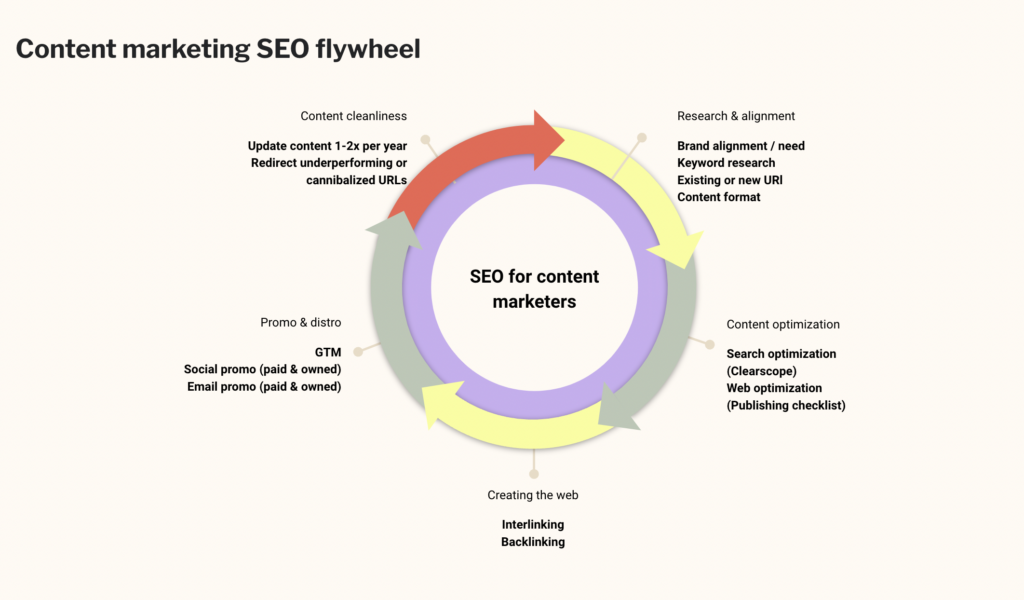16 November 2022 | Marketing
SEO for content marketers: A framework
By Tracey Wallace
SEO shouldn’t be the only goal of your content team, but it should be a strong, leading indicator of something going right––at the very least.
In an ideal world, content marketing efforts are measured by both organic search sessions to the site and leads generated.
It’s important that you do both because too much organic traffic that doesn’t convert is worthless, and to create an organic flywheel that helps better balance your organization’s paid reliance, you need organic to generate leads––and ensure that those leads become revenue for your company.
Measuring on those two goals alone will help you better structure your content team, talk to executives, prioritize your work, and get more resources for your team. Of course, this doesn’t mean that you over index on creating what a lot of folks have started calling “SEO content.”
I don’t believe in SEO content, in the same way I don’t believe in Santa Claus. It’s not a thing––and even if it is, there’s something really creepy about it.
You shouldn’t be creating content only for SEO. Rather, as I’ve mentioned before, SEO is a distribution channel, and it should be considered as such. In the same way you optimize your content so that if someone shares it on social media, the right image and headline comes through––you want to optimize your content so that it can rank well on search engines.
Now, for many organizations, the long-term impact of optimizing for search as a distribution channel is far higher than doing so for social media. After all, a content site with great SEO can generate millions of views a month, tens of thousands of leads, and incredible revenue numbers for B2B brands.
But, you don’t need to overcomplicate it. Here’s a quick chart I made for my own team in thinking through SEO for content marketing. This doesn’t cover everything, but gosh, does it cover most of it!

Research and alignment
- Getting brand alignment and understanding the larger company content needs and POV
- Keyword research to understand how to back those needs into relevant searches on the web
- Determining if you have or can publish on existing URLs or will need to publish a new one
- Determining the content format, and ultimately where this lives on your site
What I didn’t include, but should add: Writing a brief to answer these questions about competitors ranking 1-5 on Google:
- What are they doing that we are not doing? What is their POV? What is ours?
Then, build a brief that solves for the gaps in content, and builds a stronger POV in market for your company.
Content optimization
This is for after the content is written. Again, I prefer my SEO as a distribution channel rather than a content type––so my teams never write content solely for SEO. This means we always need to optimize (but that the content quality is far higher because it was inherently written for our audience, not the bots).
All right, in here, we have:
- Search optimization –– which is optimizing your content for the keyword(s) you chose. We use Clearscope for this.
- Web optimization –– this is running through the publishing checklist, every single time, for every single piece in perpetuity.
Creating the web
The web being the web that the bot will crawl to understand how your content interacts with other pages on your site and the larger internet as a whole.
This includes:
- Interlinking––looking for roughly 10 interlinks to any given piece of content.
- Backlinking––we outsource this as well as work with our partner ecosystem team to do this.
Promotion and distribution
Get yourself a good go-to-market plan in place (we’re building a GTM plan based on content type) that your larger marketing organization agrees with and understands. And then, get that into motion for each and every piece.
These should, in general, include:
- Social media promo (branded and personal)
- Lifecycle marketing (dedicated emails and newsletters)
- Paid marketing (paid social and newsletter placements––but depends on the piece really!)
- PR (depends on the piece again!)
Content cleanliness
After all of this is said and done, move on––sure––but not for long. You’ll want to update your content about 1-2x per year to continue to rank well for your target keywords. This work also includes redirecting content that is duplicative or cannibalized by other content on the site, and ultimately pruning your content garden so it can thrive.
Now, of course, this chart doesn’t include UX, or talk specifically about conversion or even how to build that go-to-market motion.
This is about SEO for content marketing, and how to better systemize it for your team and visualize it for your execs so that you don’t miss a beat (or potential traffic!) while continuing to publish high quality content.